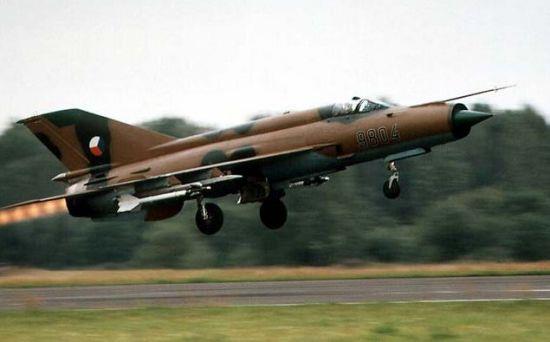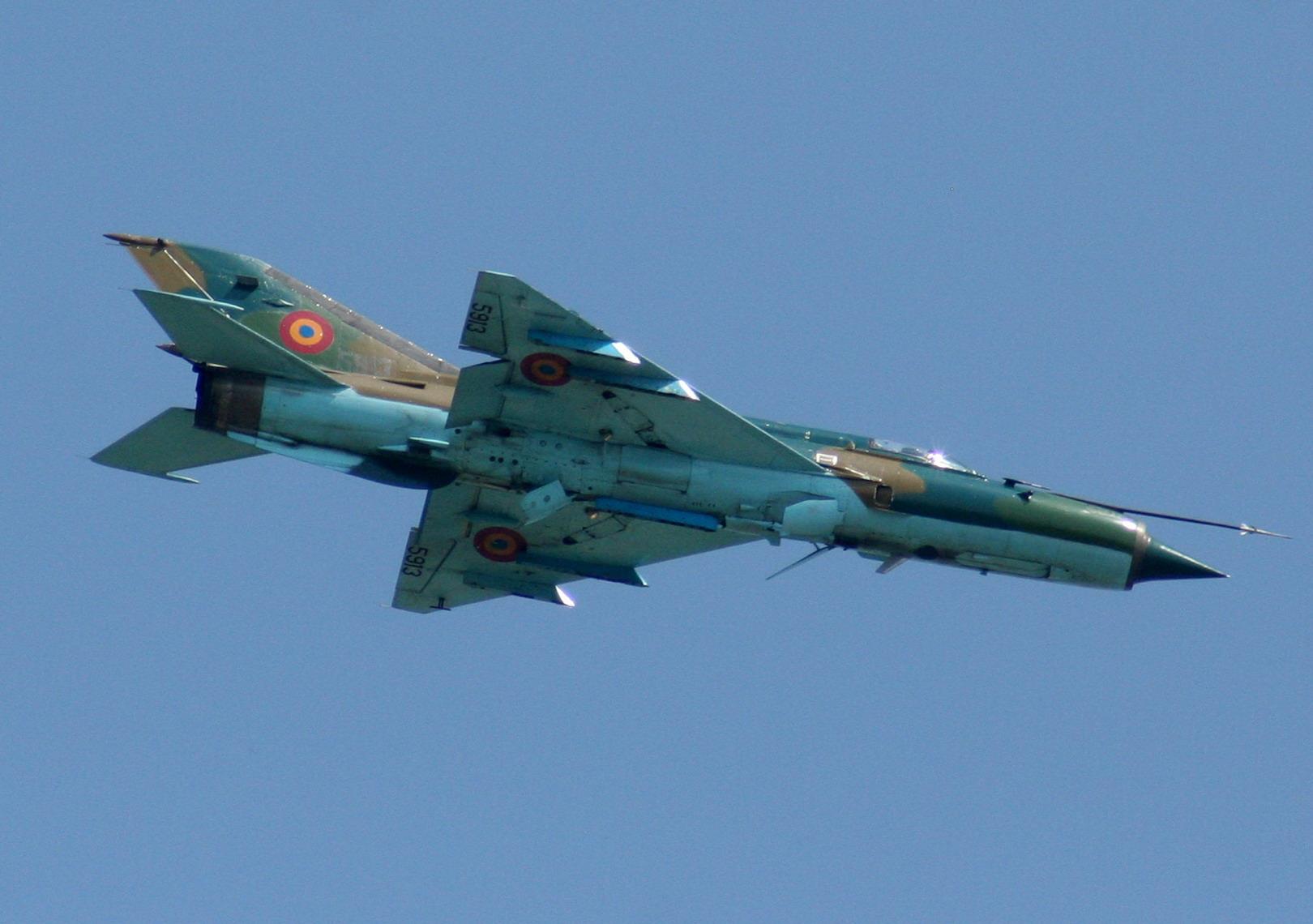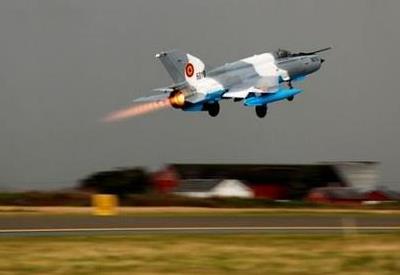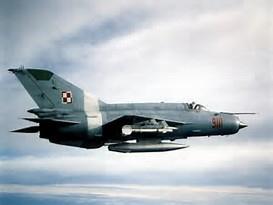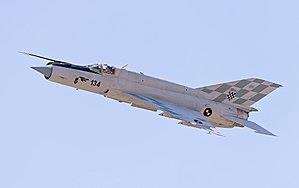S'sonic
Stealth
Menu
A free template by Lucknowwebs.com for WYSIWYG WebBuilder 8
Powered by Sispro1-S
Nigel G Wilcox
Paragon Of Space Publication
© Copyright Reserved - United Kingdom
Ideal Screen Composition 1024 x 768
SITEMAP
PSEUDO SCIENCE
SCIENCE RESEARCH
ABOUT
Desk
Supersonic
Stealth
Study
Menu
MAIN INDEX
Fastest Air Planes
Space
Transport
Menu
MiG-21-Fishbed
MiG-21 Fishbed
The Mikoyan-Gurevich MiG-21 is a supersonic jet fighter and interceptor aircraft, designed by the Mikoyan-Gurevich Design Bureau in the Soviet Union. It was popularly nicknamed "balalaika", from the aircraft's planform-view resemblance to the Russian stringed musical instrument or ołówek by Polish pilots due to the shape of its fuselage.
Display at the 1955 Soviet Aviation Day in Moscow. In an effort to improve speed and performance, the E-5 was drastically altered the following year and reworked to incorporate a delta wing design. Designated the E-4, a new prototype first flew on June 15, 1956, and its performance was admired by the Soviet Air Force.
Maximum speed: 2,175 km/h (1,351 mph) Maiden flight: 14 Feb 1956 Wingspan: 23.46 ft Passengers: 2 Introduced: 1959 Manufacturer: Russian Aircraft Corporation MiG
MiG-21 Fishbed Design & Development:
The continuation of the Mikoyan-Gurevich Design Bureau's line of fighters, the MiG-21 was designed to replace the MiG-17 and MiG-19. Seeking to produce a light-weight fighter-interceptor, designers completed the first prototype, dubbed the E-5, in time for display at the 1955 Soviet Aviation Day in Moscow. In an effort to improve speed and performance, the E-5 was drastically altered the following year and reworked to incorporate a delta wing design. Designated the E-4, a new prototype first flew on June 15, 1956, and its performance was admired by the Soviet Air Force.
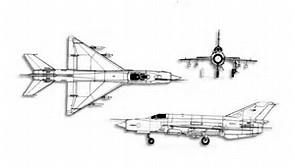

Operational History of the MiG-21:
Dubbed "Fishbed" by NATO, the early variants of the MiG-21 suffered from a variety of teething problems upon entering service.
Among these were issues with the fighter's gyro gun sight during high-speed maneuvers and the repeated failure of its AA-2 Atoll air-to-air missiles. While these were resolved, the MiG-21's utility as a fighter suffered from its delta wings which led to dramatic losses of speed in turning battles as well as a defect which shifted the aircraft's center of gravity, making it nearly uncontrollable, after two-thirds of its fuel had been consumed.
Exported widely, the MiG-21 first saw action with Soviet client states such as North Vietnam. During the Vietnam War, North Vietnamese pilots regularly flew the aircraft against American opposition. While some preferred the greater maneuverability of the older MiG-17, North Vietnamese pilots learned that the MiG-21 was effective in high-speed, hit-and-run attacks. This approach worked particularly well against American F-105 Thunderchiefs which were tasked with ground support missions. Due to the MiG's success, both the US Air Force and US Navy developed fighter training schools to improve dog-fighting skills.
Also employed by Egypt, Syria, and Iraq, the MiG-21 was used against Israel during the Six-Day and Yom Kippur Wars (1967 & 1973). During the first conflict and the subsequent skirmishing in the years after, the MiG-21 compared well the Israeli Air Force's Mirage IIICs, though both Egypt and Syria's stocks of the aircraft were badly depleted due to losses on the ground and attrition in the air.
In the Yom Kippur War, Israel's enemies again deployed the MiG-21 with mixed results. While the Syrian MiGs achieved a 1-to-1 kill ratio, the Egyptian pilots were a poor 1-to-2.
Flown by Egypt during their brief conflict with Libya in 1977, the MiG-21's star in the Middle East began to fall as Israel took delivery of American F-15s and F-16s in the early 1980s. Despite being eclipsed by newer aircraft, the MiG-21 remained in favor with nations purchasing Eastern Bloc weaponry due to its simple construction and ease of maintenance. The MiG-21 has been used extensively by the Indian Air Force in their conflicts with Pakistan since the early 1970s and played a role in the Yugoslav wars of the early 1990s.
Widely sold to African nations, the MiG-21 saw combat during the Angolan Civil War and, most recently, in the conflicts between Ethiopia and Eritrea (aerial battles in 1999-2000).
Since its introduction, the MiG-21 has been produced in four major generations with each containing a myriad of variants and upgrades. The final variant, the MiG-21bis was produced through the 1980s. To keep late-model MiG-21s current in the global environment, Russia has offered numerous upgrade packages and enhancements for the aircraft.
The MiG-21 is still in use with over twenty countries, with India being one of the largest operators. The Indian Air Force has upgraded the bulk of their fleet with the goal of keeping them in service through 2025.
General characteristics
Crew: 1
Length: 14.7 m (48 ft 2 in)
Wingspan: 7.154 m (23 ft 6 in)
Height: 4 m (13 ft 6 in)
Wing area: 23 m² (247.6 ft²)
Empty weight: 5,846 kg (12,880 lb)
Loaded weight: 8,725 kg (19,230 lb) with 2 × K-13A missiles
Max. takeoff weight: 9,800 kg (21,600 lb)
Powerplant: 1 × Tumansky R-25-300 afterburning turbojet
Dry thrust: 40.21 kN (9,040 lbf)
Thrust with afterburner: 69.62 kN (15,650 lbf)
Performance
Maximum speed:
At sea level: Mach 1.05 (1,300 km/h; 808 mph)
At 13,000 m (42,640 ft): Mach 1.76High altitude: Mach 1.8 (1,912 km/h, 1,032 knots) (2,175 km/h; 1,351 mph)
Range: 1,470 km (910 mi; 790 nmi) at 10,000 m (32,800 ft) with 2 × K-13A missiles and 800 l (180 imp gal; 210 US gal)
Service ceiling: 17,500 m (57,400 ft)
Rate of climb: 225 m/s (44,280 ft/min)
Wing loading: 452.2 kg/m² (92.7 lb/f²)
Maximum g-load: 8.5 g
Landing speed: 350 km/h (190 kn), usually with a drogue parachute
Armament
Guns: 1 × internal 23 mm Gryazev-Shipunov GSh-23L autocannon with 200 rounds
Hardpoints: 4 with a capacity of up to 2,000 kg (4,400 lb) of stores and provisions to carry combinations of:
Rockets: S-24
Missiles:
Air-to-air missiles:
K-13
K-5
R-60
R-73
R-77
R-27
Air-to-surface missiles:
Kh-66 Grom
Kh-25
Kh-31
Bombs:
KAB-500KR TV-guided bomb
4 × 500 kg (1,100 lb) bombs
Role: Fighter and interceptor aircraft
National origin: Soviet Union
Design group: Mikoyan-Gurevich / Mikoyan
First flight: 14 February 1956 (Ye-2)
Introduction: 1959 (MiG-21F)
Status: In service (see list of operators)
Primary users: Soviet Air Forces (historical)
Indian Air Force
Russian Air Force (historical)
Produced: 1959 (MiG-21F) - 1985 (MiG-21bis)
Number built: 11,496
(10,645 produced in the USSR, 657 in India, 194 in Czechoslovakia)
Variants: Chengdu J-7



